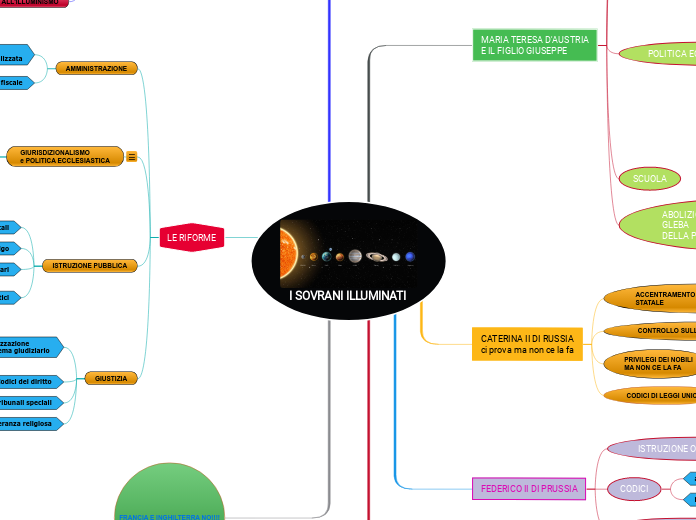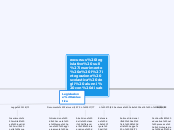I SOVRANI ILLUMINATI
The Solar System is the gravitationally bound system of the Sun and the objects that orbit it, either directly or indirectly. Of the objects that orbit the Sun directly, the largest are the eight planets, with the remainder being smaller objects, the dwarf planets, and small Solar System bodies.
FRANCIA E INGHILTERRA NO!!!!
LE RIFORME
Uranus is an oddball. It has clouds made of hydrogen sulfide, the same chemical that makes rotten eggs smell so foul.
It rotates from east to west like Venus. Its tilt causes extreme seasons that last 20-plus years, and the sun beats down on one pole or the other for 84 Earth-years at a time.
Methane in the atmosphere gives Uranus its blue-green tint. It also has 13 sets of faint rings.
GIUSTIZIA
leggi di tolleranza religiosa
abolizione dei tribunali speciali
Codici del diritto
Centralizzazione
del sistema giudiziario
Uranus has 27 moons that we know of. Five of the moons are large and the rest are much smaller.
Name these 5 moons.
tribunali e carceri
norme uniche
ISTRUZIONE PUBBLICA
nuovi programmi scolastici
fisica, economia
politica, chimica
medicina, diritto
università e istituti secondari
scuola elementare dell'obbligo
Scuole pubbliche statali
How long does it take for Uranus to go around the sun?
GIURISDIZIONALISMO
e POLITICA ECCLESIASTICA
DOTTRINA CHE DISTINGUEVA IN MODO NETTO GLI AMBITI DI COMPETENZA TRA STATO E CHIESA
limitando quelli attribuiti a quest'ultima alle sole questioni spirituali
soppressione di ordini religiosi
espulsione dei gesuiti
ridurre i privilegi del clero
esenzione dalle imposte
tentativo di controllo da parte
da parte dello stato sulla chiesa
avere giurisdizione (entrare nel merito, avere autorità giuridico e legale) negli atti emanati dal pontefice o dai vescovi e che quindi potevano diventare operativi solo con il consenso del re.
I sovrani avrebbero voluto intervenire sulle nomine degli ecclesiastici, e sulla regolamentazione dei matrimoni
A planet's day is the time it takes the planet to rotate or spin once on its axis.
Write down Uranus's day measured in Earth days.
chiese nazionali
AMMINISTRAZIONE
sistema fiscale
BUROCRAZIA
competente e specializzata
ASSOLUTISMO ILLUMINATO
Neptune is about the size of Uranus and is known for supersonic strong winds.
Neptune is far out and cold.
The planet is more than 30 times as far from the sun as Earth.
Neptune was the first planet predicted to exist by using math, before it was visually detected. Neptune is about 17 times as massive as Earth and has a rocky core.
ISPIRAZIONE ALL'ILLUMINISMO
How many days
How long does it take for Neptune to go around the sun?
introduzione di riforme "dall'alto"
How many Earth days
A planet's day is the time it takes the planet to rotate or spin once on its axis.
Write down Neptune's day measured in Earth days.
consolidamento dello stato monarchico
Position
GUSTAVO DI SVEZIA
Mars is a cold, desert-like place covered in dust. This dust is made of iron oxides, giving the planet its iconic red hue.
Mars shares similarities with Earth: It is rocky, has mountains, valleys and canyons, and storm systems ranging from localized tornado-like dust devils to planet-engulfing dust storms.
RITORNA AD UN REGIME ASSOLUTISTICO
TENTA le riforme ma non e la fa
confisca dei beni del clero
tolleranza religiosa
libertà di stampa
Our Solar System has eight “official” planets which orbit the Sun.
Each planet is at a different distance from the sun. Name its position.
FEDERICO II DI PRUSSIA
Earth is a water world, with two-thirds of the planet covered by oceans.
It's the only world known to harbor life.
Earth's atmosphere is rich in nitrogen and oxygen.
Its name originates from 'Die Erde,' the German word for 'the ground.'
Earth may once have had two moons, nowadays it has just one.
GUERRA DI CONQUISTA
CODICI
insindacabilità dei giudici
abolizione della tortura
A planet's day is the time it takes the planet to rotate or spin once on its axis.
Write down the Earth's day in hours.
ISTRUZIONE OBBLIGATORIA
CATERINA II DI RUSSIA
ci prova ma non ce la fa
Venus is Earth's twin in size and has no moons.
Its surface has various mountains and volcanoes. Because of its thick, toxic atmosphere that's made of sulfuric acid clouds, Venus is an extreme example of the greenhouse effect. The average temperature on Venus' surface is 900 F (465 C).
Venus spins slowly from east to west, the opposite direction to most of the other planets.
The Greeks believed Venus was two different objects — one in the morning sky and another in the evening. Because it is often brighter than any other object in the sky, Venus has generated many UFO reports.
CODICI DI LEGGI UNICHE
PRIVILEGI DEI NOBILI
MA NON CE LA FA
SERVITU' DELLA GLEBA
How long does it take for Venus to go around the sun?
CONTROLLO SULLA CHIESA ORTODOSSA
soppressione di conventi
e confisca dei beni
A planet's day is the time it takes the planet to rotate or spin once on its axis.
Write down Venus's day measured in Earth days.
ACCENTRAMENTO AMMINISTRAZIONE
STATALE
MARIA TERESA D'AUSTRIA
E IL FIGLIO GIUSEPPE
Mercury is the smallest, only a little bit larger than Earth's moon. Mercury has no moon.
It experiences dramatic changes in its day and night temperatures: Day temperatures can reach a scorching 840 F (450 C), which is hot enough to melt lead. Meanwhile, on the night side, temperatures drop to minus 290 F (minus 180 C).
It also has a very thin atmosphere of oxygen, sodium, hydrogen, helium, and potassium and can't break-up incoming meteors, so its surface is pockmarked with craters, just like the moon.
ABOLIZIONE DELLA SERVITU' DELLA GLEBA
DELLA PENA DI MORTE. DELLA TORTURA
SCUOLA
POLITICA ECCLESIASTICA
tolleranza per le minoranze
religiose (ebrei), matrimoni misti
anche il divorzio i non cattolici
legifera su materia ecclesiastica
campane, ceri, reliquie
soppressione di ordini
numero dei preti ed età
feste religiose
diritto d'asilo
diritto di censura
abolizione del tribunale dell'inquisizione
tassazione dei beni del clero
CATASTO
CONSIGLIO DI STATO
RIDUCE L'AUTONOMIA LEGISLATIVA
GIURIDICA E FISCALE DELLE PROVINCE









